Southern Africa Jewish Genealogy SA-SIG
A History of the Bnei Akiva Youth Movement in South Africa
by Kelly Modlin © 2003
Editor: Dr Saul Issroff
Copyright © 2004 Saul Issroff, Mike Getz, SAfrica SIG
and Jewishgen Inc.
URL: http://www.jewishgen.org/SAfrica/youth-movements/history/modlink/index.htm
Date: 23 July 2004
|
At the outset I would like to Honour the Memory of our Chaverim who gave their lives in the Defence of Israel. “Al Kidush Hashem”
May their Souls Be Bound Up In “The Bond Of Eternal Life”

Avram Issar Halevi Katz z"l
Fell in the Defence of Chanita 1st July 1938
Born Lituania, came to S. Afr. age 18. In 1933 together with Joe Green z"l and Rabbi Leonard Oshry founded the Young Mizrachi Organization. Went on Aliyah in 1938 to Kvutzat Avraham.
Chatzi (Yechezkel) Berelowitz z"l
Fell in the Defence of Kfar Etzion and Jerusalem – 8th May 1948.
Born Johannesburg 1918. Went on Aliyah 1943. Chaver Kfar Etzion. Buried Har Hertzl.
Harry (Zvi) Lipshitz z"l
Fell in the Defence of Kfar Etzion and Jerusalem – 14th May 1948.
Born Ukraine 1921. Came to S.Afr. 1935. Went on Aliya 1945. Chaver Kfar Etzion. Buried Har Hertzl.
Irving (Yitzchak) Glazer H’Lavi z"l
Killed by a Sniper’s bullet Sinai Campaign 1st November 1956.
Born London 1st September 1935. Arrived in S.Afr 1949. Came on Aliyah 1954. Chaver Kibbutz Shluchot. Buried Shluchot. Yesterday the 27th day in the month of Cheshvan was exactly 47 years that he fell in battle.
Avraham David (Dov) Katz z"l
Killed 2nd Day of the Yom Kipur War – 10th October 1973.
Born Boksburg 1939. 1957 came to study at Yeshivat Keren Beyavne, returned to S. Afr. in order to marry and came on Aliya in 1961. Lived in Jerusalem.
I have intentionally written a few lines on each of the fallen in order to emphasis the background of those who were instrumental in the building of the Movement and those who followed in their footsteps.
|
Introduction
My association with Bnei Akiva, then known as Hashomer Hadati starts from about the year 1944 when at the age of eleven I was invited on a Shabbat morning to join the games which were being played in the corridor of the Bertrams Shul - Kimberley Road, Johannesburg. Tzvi Lipshitz z"l was the madrich. From then on until 1956 when I came on Aliyah all that I put into words is personal knowledge. What came before and afterwards I have gleaned from various other sources.
The Immigrants of the 1920’s
Many of the Jewish immigrants, who arrived in South Africa from Lithuania and Latvia during the 1920’s were influenced by the Socialist Revolution. Very few of them were religiously orientated and already had had a secular education “Back Home.” This and the prolonged depression in the Country made work hard to come by. If one had a job, even a lowly paid one, one clung to it. Many were quick to “Throw off the Shackles of Judaism.” “The Jewish Workers Club” in Doornfontein attracted the secular immigrants from Eastern Europe whereas the Zionistically inclined joined the ranks of the Hashomer Hatzair or the Zionist Socialists
- 2 -
However there was always a small number among the young immigrants who were Religiously orientated and clung to their Judaism withstanding the hardships of the times. They were to be the forerunners of the Chalutzik Zionist Youth Movement – Bnei Akiva. These chaverim like Avraham Katz and Tzvi Lipshitz z"l were born into families with Zionist backgrounds and affiliated to the Mizrachi Movement, which in 1902 was founded in Vilna by Rabbi Reines. They arrived in S. Afr. already imbued with the learning’s of famous Rabbis such as Judah Alkalai, Tzvi Hirsch Kalischer, Shmuel Mohliver, Isaac Jacob Reines and Abraham Isaac Kook. They were the forerunners of Religious Zionism and the Return to Zion when the general clamor in Europe was for Emancipation.
1933-34
These young “Olim” to South Africa plus a small number of locally born S. Africans not finding their place within the framework of the Secular Zionist and non-Zionist organizations set out to establish the then Young Mizrachi Organization. In the year 1932 Rabbi Eliezer Franklin was sent out from Eretz Yisrael in order to organize the Movement and remained in the Country for quite a while. At the outset the Movement consisted exclusively of young men. Its founding members were the late Avraham Isser Katz z"l, the late Joseph (Joe) Greene z"l and Rabbi Leonard Oschry. They received assistance from the Mizrachi Organization of South Africa and had their office in Exploration Buildings, Commissioner Street-Johannesburg.
Not long after its formation the Movement joined the Transvaal Zionist Youth Executive as an affiliate, attending their annual conferences and activities. Slowly their ranks began to swell and in 1934 a Junior Movement of the Young Mizrachi was formed with a group of children, mostly under the Barmitzvah age. This Movement later to be known as Hashomer Hadati (which already existed in Europe) was led by Leonard Oschry and held its meetings in the basement of the Jewish Guild – Von Brandis Street, Johannesburg.
Torah V’Avodah
The establishment of the Religious Kibbutz Movement and the growth of the Religious labor Movement Hapoel Hamizrachi in Eretz Yisrael – 1922 had a great influence on the chaverim. Membership was limited to “a laborer who lived by the labor of his own hands without exploiting others and who acts in accord of the Torah in his private and cultural life.” In other words: “The Land of Israel, for the people of Israel According to the Torah of Israel.” The year 1935 already saw the first Chalutzik Aliyah with Sadie Ratner in August 1935. Later, September the same year the late Avraham Isser Katz joined Kvutzat Avraham which later went on Hityashvut to the original Kfar Etzion. July 1937 saw a further step in the development of the Movement with the visit of Rabbi Meir Bar-Ilan (Berlin) after whom the University Bar-Ilan is named. At a gathering held in his honor besides the male members of the Hapoel Hamizrachi, invitations were extended to girls as well. A resolution was passed opening the ranks to female sex.
1938
As a result of opening up the ranks, the movement began to grow extensively. April and May saw the forming of Hashomer Hadati groups in Jeppe. Leib Frank, who was to become active in the Zionist Movement and Secretary of the South African Federation in Israel, was their Madrich. Soon Gedudim were established in Bertrams, Kensington, Mayfair and the Northern Suburbs. A very active group met at Rabbi Moshel’s Talmud Torah in Sherwell Street, Doornfontein. The driving force behind this was the late Zvi Lipschitz who fell in the defence of Kfar Etzion. The focal point of the Movement’s activities, were centered in the Mizrachi Offices, which were situated in Store Bros Building – Eloff Street. (As a youngster I remember visiting the offices on various occasions, the dark staircases and the lift which was out of order). Besides the Transvaal, groups were organized in Capetown, Oudtshoorn, founded by the late Simon Weinstein – known to all South Africans who came on Aliyah. Father to each and every Machalnic (Volunteer to the Israeli Defense Force), Port Elizabeth, Vryheid and Springs.
- 3 -
These were years of great stress, what with the rise of Nazism in Europe and the British embargo on Aliya. Aliyah to Eretz Yisrael was discussed and planned, although there were no immigration Certificates for South Africa. Hachsharah on a farm was planned and also a group was set up who on Sunday mornings would go out to Balfour Park where a Vegetable Patch was worked. With the outbreak of World War II most of the senior chaverim and madrichim joined the Army, thus leaving the running of the Movement to chaverot and older chanichim.
1945-1948
With the end of hostilities and the Allied Victory over Nazi Germany, like all the other Chalutzik Zionist Youth Movements, Hashomer Hadati’s ranks expanded. In Eretz Yisrael the Kibbutz Movement gathered strength and new Kibbutzim were being formed and wherever possible new Settlements sprang up. The same applied to Hakibbutz Hadati whose ranks were drawn from Hapoel Hamizrachi and Bnei Akiva. All the Chalutzik Movements, whose ideologies were based mainly on educating towards Kibbutz, were faced with a big problem. Certificates, which the British Mandatory authorities issued for emigration to Palestine were very hard to come by. The Certificates issued to South Africa were very few and the competition between the various Zionist Youth groups was very keen. 1945 also saw the first organized group of chaverim who went on Aliyah to Kfar Etzion. They followed in the footsteps of individual chaverim and chaverot who had preceded them. They were lucky to embark aboard a ship seeing to a consignment of some 100 mules sent from South Africa to Palestine. They sailed up the East Coast of Africa through the Suez Canal to Haifa. It was arduous work especially in rough weather. To the best of my knowledge there were some ten chaverim from South Africa who were members of Kfar Etzion when on the 14th May 1948 the Gush fell. Besides the late Tzvi Lipschitz and Chatzi Berelowitz z"l, who fell in the defense of the Gush and Jerusalem, the remaining chaverim dispersed each going his own way. There were those who joined the new Kfar Darom, today a Moshav Shitufi know as Bnei Darom, situated near the town of Ashdod. Two returned to South Africa and as for the remaining chaverim they made new lives for themselves in Israel.
The years to follow were years of extensive activity and expansion. The Movement was divided up into three main Shichvot (age groups): Gurim (Cubs), Roiim (Shepherds) and Bogrim (Senior), at some stage Bachad. Uniforms and headgear were designed for the various age groups. If my memory serves me right our badge was based upon that of the Movement in England. The Gedudim were named after the various Kibbutzim and Settlements such as Biriya and Kfar Etzion. To be chosen as a candidate for the Madrich’s Training Course was a great honor. Educational material was printed and distributed among the members. Besides the annual Summer Camps, Winter Seminars were organized in the various Provinces. Not to mention picnics, camp reunions and weekends. Every year there was an annual Yom Hitcharut, a day of sport and scouting, which on various occasions took place at Bacher’s Farm.
Here it is important to mention that from the outset, many of the Founders of the Movement were, for economical reasons forced to work on Shabbat and in many cases uneducated as far as basic Jewish knowledge was concerned. However this never stopped them from organizing and running groups of youngsters who, after completing their schooling looked for jobs as Shomrei Shabbat. In fact the great majority of chaverim were drawn from traditional but Non Religious homes. There were cases where chaverim couldn’t eat at home as their mother’s kitchen weren’t Kasher or they cooked for themselves and had their own utensils and cutlery. There were also cases where the opposite happened and the kitchens became Kosher.
It is important to stress that South Africa is an exception to the world wide religious revival. It is the only country where the revival was primarily sparked by a youth movement against the apathy and often objection of the Rabbinate (with few notable exceptions) and communal leaders. Credit for initiating and sustaining for many years a new approach to youth and their return to a true Jewish way of life and tradition belongs primarily to the South African Bnei Akiva.
- 4 -
1948–1953
The establishment of the State of Israel brought about the intensification in the Movements activities. It was also a very sad time to learn about the fall of the Gush (Etzion), on the very day that the State of Israel was born. The death of two of our chaverim and destruction of three of our Kibbutzim, Kfar Etzion, Masuot Yitzhak andEin Tzurim was a real blow. To this list of losses must be added two Kibbutzim situated in the South, Kfar Darom and Beirot Yitzchak.
How well I remember that whenever someone went on Aliyah we would congregate at the home of Mrs Yoselowitz, (grandmother of the Friedmans and Fishers) awaiting the arrival of Doddie Aberman. We would climb aboard the back of his open truck (bakkie) and off we would go to the Palmietfontein Airport in order to say farewell to those going on Aliyah.
By now the Machon L’Madrichei Chutz L’Aretz (Institute for Group Leaders from the Diaspora) had been established and the first graduates had begun to return after a year of intensive study and work in Israel. They returned full of energy and imbued with new ideas, which they instilled into the Movement. While in Israel they came in contact with chaverim of Bnei Akiva and spent time on Kibbutzim of Hakibbutz Hadati. For the first time we saw Knitted Kipot (Skull caps) and obviously the chaverot set about learning the arts of crocheting. The latest Songs and folk dances were learnt. This was a most important time, a time which was to shape our future lives. I can very well remember the March and Demonstration held at Balfour Park denouncing the Bevin White Paper. Chief Rabbi L.I. Rabinowitz, who during the War was a Chaplain in the British Army removing his Medals and casting them onto the ground.
1949 saw the arrival of the first Hashomer Hadati Shaliach to South Africa. Pinchas Spielman was a member of Kfar Darom (In later years he became the Public Relations Officer of the Bar Ilan University). Originally he hailed from America where the Religious background of the Tnua was well above that of South Africa. As mentioned previously, the majority of the chaverim came from non-religious homes. Such institutes such as Yeshivot were unknown in the Country. He went about raising the educational activities of the Movement. He imbued in the chaverim the awareness of a limited Jewish knowledge and the understanding that the situation required revision. This is the place to mention the late Rabbi Michael Kossowsky z"l and Dr. H. Abt z"l. They were among the few rabbinical personalities in the whole of S. Africa who supported and encouraged the Tnua. A permanent Minyan was set up at the Rabbi Moshel’s Talmud Torah in Sherwell Street – Doornfontein. It was run solely by the chaverim who came from near and far in order to participate in the Services. In due time it also fuctioned on the High Holidays and Chagim. From Sherwell Str the Minyan moved to Corona Lodge – Berea and then to the premises of the Johannesburg Beit Din, Reiley Str. – Yeoville.
The leadership of the Tnua came to the conclusion that in order to further Chalutzik Aliyah to Kibbutz the potential candidates would require practical experience. For this purpose a Hachsharah was established at Hirsch’s Farm situated North of Johannesburg. Most of the chaverim left for Israel in May 1950 and settled at Kfar Darom. The purpose of their joining Kfar Darom was to strengthen the fledgling Kibbutz and joining the S. African chaverim who had been members of Kfar Etzion. In 1951 for various ideological as well as social reasons three chaverim, Meir Tamari (Leopold Fagov), Aba Nurick and Yossie Markowitz, left in order to find a Kibbutz more to their likings. Finally they settled on Kibbutz Shluchot, which was to became the home of all those who chose to make the Kibbutz their way of life. Obviously not all of those going on Aliyah chose the kibbutz movement as their home. However I think that it’s safe to say, that a large majority of members who passed through the ranks of the movement, came on Aliyah at some stage of other of their lives and today play an important part in the daily life of the State of Israel.
1949 will also be remembered, as the year in which serious thought was given to the establishment of a Yeshiva whose students would be drawn mainly from the Hashomer.
- 5 -
Hadati. In April 1950 at the Hashomer Hadati Conference it was decided to set up a Yeshiva. This decision was made despite the opposition of rabbinical and official educational circles. On the 15th February 1951 a Yeshiva Katana was opened consisting of four classes situated at the Beth Hamedrash Hagadol, Saratoga Avenue as well as the Corona Lodge, (Moadon of the Hashomer Hadati Movement) O’Reilly Str. – Berea, Johannersburg. Comprising seven pupils aged 14-15 the classes were held mornings, afternoons and evenings.
1953-1956
At the National Conference-1958 a resolution was passed by which the Hashomer Hadati Movement officially changed its name to Bnei Akiva. By now the ranks of the Movement had grown extensively and activities had expanded to the outlying districts. Groups were opened in Pretoria, Durban, Benoni, Port Elizabeth, East London etc. Besides the Summer Camps, Seminars and Machanot Avodah were organized during the July Holidays. The Movement underwent a complete change as a result of this affiliation to the World Organization of Bnei Akiva, with its Headquarters situated in Israel. Uniforms, Flags, Badges Emblems and Anthem had to be changed to those of Bnei Akiva. Obviously as a result of being part of an International Zionist Organization the Political Situation (Parties) in Israel made an impact on the senior members. In addition to this the name of the Yeshiva was also officially changed to "Bnei Akiva Yeshiva" and became the first Bnei Akiva Yeshiva to be established outside Israel.
With the termination of Pinchas Spielman’s Shlichut to South Africa the Movement remained without a Shaliach for a few years. This was to change with the arrival of Meir Tamari and Kibbutz Hadati’s decision in which Shluchot was to absorb all future Kibbutzik Aliyah. The following years were to see a constant flow of chaverim to Shluchot and Israel in general. To a great extent all this was due to the dynamic personality, organizational and educational abilities of Meir. 1955 saw once again the establishment of a Hachshara at Wieler’s Farm, situated in the Grassmere District of the Transvaal. Six of the participants arrived at Shluchot in June 1956 thus increasing the ranks of those who had preceded them.
January 1954, the name of the Yeshiva changed to Yeshiva College, which was to become the first full Yeshiva established with full board for students. A house situated in Parktown, was kindly lent by the Mirkin Seeff family for this purpose. In July of the same year Rabbi David Sanders was brought out from Telzer Yeshiva U.S.A. to become the first Dean of the Yeshiva. Although he came from a completely different background, he understood the special qualities of Bnei Akiva in South Africa and the important part it could play in the religious development of the Jewish Community.
- 6 -
The next step in the development of the Yeshiva College was that in Jan.’58 it became a full time high school and yeshiva. A secular principal and teachers were employed, with Limudei Kodesh (Religious Studies) in the morning and secular in the afternoon – a revolutionary concept in the history of South African Jewry. The first students matriculated – Dec. 1962, doing so with exemplary distinction. As the Yeshiva grew it became imperative that a permanent site be established and in Nov. 1960 the foundation stone for buildings was laid in Glenhazel. By 1984 it had some 800 students, a nursery school with 120 children, a pre-grade school with 40 children and primary school with 300 pupils. In addition to all this the Menora Girls High School was opened – Jan.’70 and in Jan.’73 saw the establishment of a Yeshiva Gedolah. None of this could have come about without the insight of leaders of the then Hashomer Hadati in the early 1950’s.
Camps
1941 saw the organization of the first Summer Camp. It took place at Meyerton – Transvaal, where a Jewish Boarding School, run by Colonel Levenson was put at their disposal during the December holidays. Some twenty or so chaverim attended. The main driving force behind the organization of the camps was the late Solly Aber and Dave Wacks, past Chairman of the Hapoel Hamizrachi, head of Bnei Akiva Camps to come, General Secretary of the H.O.D. He was also a well known philatelist and employee of the S. Afr. Zionist Federation for many years. The Summer Camps began to become an integral part of the Tnua. During the War years they were held at Kroonstad on the banks of the Wilge River and Vereeniging on the Vaal River. The year 1946/47 the first Hashomer Hadati Camp organized on a National basis took place at Lakeside, Cape Town. Intensive efforts were put into the organization of Machaneh from Train bookings, seeing that the equipment was taken out of storage and trucked to the Camp Site, where the Advance Guard awaited its arrival. Food supplies had to be ordered, arrangements had to be made with Vegetable, Fruit, Meat and Fish Wholesalers etc. The greatest honor was to be chosen as a member of the Advance Guard, which left about a week ahead of the main body in order to set up camp. The excitement of the Train journey to Lakeside, Port Elizabeth, East London or Mossel Bay, never failed to thrill those who were privileged to attend Machaneh. The duration of Camp was organized to the smallest detail.
The day began with the blowing of the reveille by the camp bugler, (I was privileged to do so all the years that I attended Camp), morning prayers, assembly – hoisting of the national flag and tent inspection. The camp beds, which were made up on ground sheets, had to be rolled up neatly and spaced out evenly. The same applied to the chanichim’s personal belongings. The tent flaps were rolled up nicely and the Guy Ropes were tightened. All these activities were organized on a competitive basis and in true Scouting tradition. The daily activities varied from Jewish and Religious studies to Tiyulim and Bathing. New friendships where established between the Chanichim of the various Provinces and old ones were renewed. Come the last day of camp, early to rise each and every one had to see to the packing of his personal belongings, which was brought to the centre of the campsite. Only then did the task of dismantling what had been set up three weeks previously begin. Tents were taken down, folded neatly, tied up and checked to see which required repair. The same applied to the kitchen, showers and all the other equipment, which had to be stored away. Actually it was rather sad seeing three wonderful weeks coming to an end. The personal belongings of the campers scattered all over with their owners either sitting or lounging on them. The last minute goodbyes, exchanging of addresses and telephone numbers were made. All gathered for the last Assembly, where final instructions before dispersing were given and finally the singing of the Movement’s and National Anthem "Hatikvah." A few senior chaverim (Rear Guard) remained behind waiting for the "Pickfords" Van in order to load and see that all the equipment was sent off for storage till the following year.
- 7 -
Today things have changed, when in the good old days we moved from Campsite to Campsite today the Bnei Akiva has a permanent Site at Hartenbos in Mossel Bay. However with all its sophistication and laid-on facilities Machaneh still remains the highlight of Bnei Akiva’s activities. From some 25 chaverim attending the first camp at Meyerton way back in 1941 I believe that in recent years the numbers attending the Summer Camps centre around 700 participants.
Although I endeavored to obtain information appertaining to the modern history of Bnei Akiva I’m afraid to say that I haven’t been too successful. I don’t know to what extent the present situation, especially with sections of the Jewish Community emigrating from S. Africa, has had on the Bnei Akiva Movement. However I’m aware that there is a constant Aliyah to Israel from the ranks of the Movement. Neither do I know what the present Ideology is and towards what they educate. Of one thing I’m certain, that it isn’t Kibbutz. Perhaps the Motto "Torah and Avodah" has changes with the word "Avodah" being removed.
In conclusion while compiling this short History of the Bnei Akiva Movement in South Africa my thoughts took me back some 60 years. Happy memories of years gone by, which were perhaps the best of my life and never to return. Years of extensive activity mostly connected to the Movement and preparations for the day of Aliyah to Kibbutz. Remembering all the picnics, weekends, seminars, camps and their reunions in which I participated. Then there were the long conversations, which lasted into the late hours of the night, conversations that usually took place on street corners or escorting the chaverot to and from meetings and gatherings. The most interesting of all was going over old photographs recognizing faces and remembering their names and all the good times we had together.
I hope that I’ve done justice to what I’ve written. I know that there is very much more to tell but as this was meant to be a short history of the Bnei Akiva in S. Afr. I had to try and be as brief as possible. I would have liked to mention the names of so many more chaverim who filled the ranks of the Movement. Without them Bnei Akiva could never have been what it is today, a major factor in the South African Jewish Community.
Information regarding the early years of the Movement before my joining were taken from articles written by the late Dave Wacks z"l, Miriam Leventhal (née Ratner) z"l and Zelig Sher whom I wish a long life.
Kelly Modlin – Kibbutz Shluchot.
kellym@shluhot.org.il
December 2003.
Conferences: 1940 and 1942
Upper photograph:
7th Kinnus of Young Mizrachi, 28.1.1940
Lower photograph:
9th Kinnus of Young Mizrachi, 15.2.1942
|
click on the image for a larger version
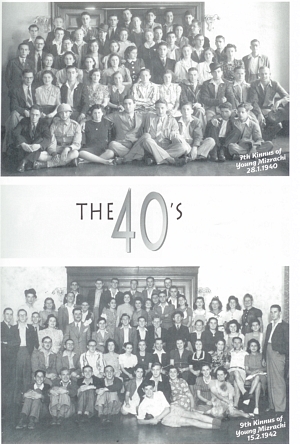 |
Hashomer Hadati Camp, East London, before changing the name to Bnei Akiva.
East London Camp 1952-1953
|
click on the image for a larger version
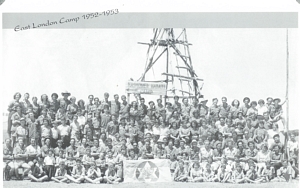 |
Lakeside Camp 1947 and 1948
10th Hashomer Hadati Camp,
1st Lakeside 1947/8
|
click on the image for a larger version
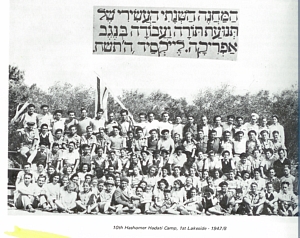 |
Opening Ceremony - Yeshiva College, Rabbis and Students
|
click on the image for a larger version
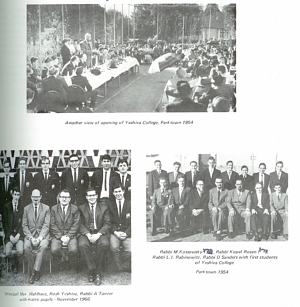 |
Pictures: History of Bnei Akiva, South Africa
Picture captions
- top: Young Hapoel Mizrachi Conference 1943
- middle: Meyerton Camp 1941-42 at the pool
- bottom: Meyerton Camp 1941-42
|
click on the image for a larger version
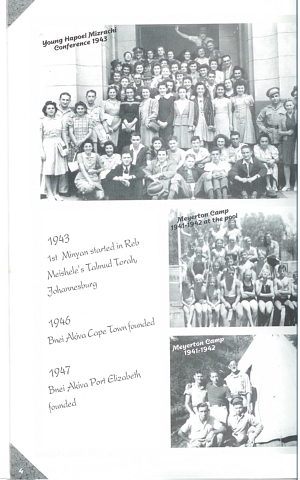 |
Sam Kaplan, Leib Frank and Dave Wacks in army uniform, 1942.
Dave Wacks [right], father of Naomi Roffman, was one of the founders of Bnei Akiva, South Africa, and fought at the battles of El-Alamein and Tobruk during World War II. |
click on the image for a larger version
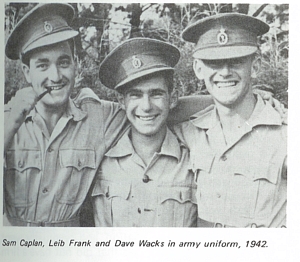
|
|








